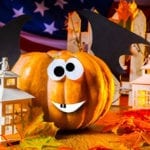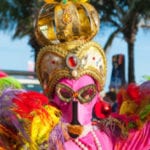 Weird Stuff
Weird Stuff  Weird Stuff
Weird Stuff  Politics
Politics 10 Political Scandals That Sent Crowds Into the Streets
 Weird Stuff
Weird Stuff Ten Bizarre Facts About The Doge Meme
 Our World
Our World 10 Ways Your Christmas Tree Is More Lit Than You Think
 Movies and TV
Movies and TV The 10 Coolest Stars to Set Sail on The Love Boat
 History
History 10 Things You Didn’t Know About the American National Anthem
 Technology
Technology Top 10 Everyday Tech Buzzwords That Hide a Darker Past
 Humans
Humans 10 Everyday Human Behaviors That Are Actually Survival Instincts
 Animals
Animals 10 Animals That Humiliated and Harmed Historical Leaders
 History
History 10 Most Influential Protests in Modern History
 Weird Stuff
Weird Stuff 10 Funny Ways That Researchers Overthink Christmas
 Politics
Politics 10 Political Scandals That Sent Crowds Into the Streets
 Weird Stuff
Weird Stuff Ten Bizarre Facts About The Doge Meme
Who's Behind Listverse?

Jamie Frater
Head Editor
Jamie founded Listverse due to an insatiable desire to share fascinating, obscure, and bizarre facts. He has been a guest speaker on numerous national radio and television stations and is a five time published author.
More About Us Our World
Our World 10 Ways Your Christmas Tree Is More Lit Than You Think
 Movies and TV
Movies and TV The 10 Coolest Stars to Set Sail on The Love Boat
 History
History 10 Things You Didn’t Know About the American National Anthem
 Technology
Technology Top 10 Everyday Tech Buzzwords That Hide a Darker Past
 Humans
Humans 10 Everyday Human Behaviors That Are Actually Survival Instincts
 Animals
Animals 10 Animals That Humiliated and Harmed Historical Leaders
 History
History 10 Most Influential Protests in Modern History
10 Fascinating Stories About the Most Popular Halloween Candies In America
In late September, Candystore.com compared the sales of Halloween candy to determine the most popular. The top 10 candies weren’t surprising, but the breakdown of the favorites by state offered some interesting results. For instance, Ohio’s favorite Halloween candy is Blow Pops. In Montana, it’s Dubble Bubble Gum; Georgia’s fav is Swedish Fish and Lemonheads for Louisiana. But none of these four candies made the top 10 for the nation.
Here are those list toppers in order of popularity, least first, with morsels of their sweet—and not-so-sweet —origins mixed in.
Related: 10 Unique Halloween Traditions From Around The World
10 Candy Corn
If you’re scratching your head as to how candy corn made the top 10 in popularity, you are not alone. But the statistics don’t lie. According to the National Confectioners Association (NCA), 35 million pounds of candy corn are sold around Halloween. That’s nine billion kernels of candy corn sold, and if they were laid end-to-end, they’d circle the Earth more than four times.
The popularity of this candy is the most polarizing, most contentious of the confections on this list. People either love it or hate it, with the numbers tilting toward the latter. The secret to its popularity may be because it is also the oldest candy on this list. For most (52%), candy corn is a tradition, and Halloween cannot come and go without a bowl of it—sometimes with peanuts mixed in—sitting out for guests to graze on—followed by the traditional dumping of most of the bowl into the trash at Thanksgiving.
In the late 1800s, there were a number of candies on the market called buttercreams, usually molded into shapes inspired by agriculture or nature, such as clover, chestnuts, or turnips. In a country that was still heavily agrarian, these confections were meant to appeal to farmers and their families. Candy corn, too, was agrarian-inspired but was a novelty, layered in bright colors.
George Renninger, who worked 68 of his 87 years at Philip Wunderle Candy Company, is usually credited with creating the candy corn sometime in the 1880s. Renninger’s recipe called for melting corn syrup, fondant, vanilla, sugar, and marshmallow crème into a candy slurry, dividing and coloring them—yellow, orange, and white—then pouring them into triangular molds one color at a time. Allowing the candy to cool inside the mold melds the three colors in layers. The pouring of the colored slurry into molds had to be done by hand, the so-called stringers walking up and down the line. While now automated, the way to make candy corn has remained largely unchanged.
Lately, there has been a controversy over the right way to eat candy corn. The NCA surveyed consumers of the confection and found that 47% ate the whole thing in a gulp, while 43% ate it layer-by-layer, starting with the white tip. Just a tenth ate it by beginning with the wider yellow end.[1]
9 Tootsie Pops
There has been a long-standing mystery surrounding Tootsie Pops. No, I’m not talking about the number of licks it takes to reach the Tootsie Roll center, but we’ll get to that. The mystery is why a Native American has appeared on some of the Tootsie Pop wrappers ever since the candy was inaugurated back in 1931. The man (boy?) wears a traditional headdress and points a bow and arrow at a star.
According to Snopes.com, only about 30% of all Tootsie Pops have the icon on its wrapper. Its relative rarity has led to a rumor that these “special” wrappers can be redeemed for a prize. While some candy companies back in the 1930s had promotions where kids could mail in a certain number of wrappers for prizes, the creators of Tootsie Pops—Sweets Company of America and later Tootsie Roll Industries (TRI)—have never been one of those companies.
TRI claims they still get about 150 letters with these special wrappers enclosed from kids hoping to receive a prize. Since 1982 the company has sent them a consolation letter with a short story about a Native-American appearing in the room of the unnamed Tootsie Pop creator, offering him the secret of making a new lollipop shape. When the inventor agrees, the Native-American shoots an arrow at a star, destroying it so that the inventor could be inspired by the moon’s shape to make a round lollipop. While charming, the story is not particularly satisfactory, especially if you were expecting a prize. Nor is the company’s other explanation for the icon: the star is a symbol for luck. That doesn’t explain what the Native-American signifies. A better answer is the mystery itself. It generates plenty of publicity.
TRI, after all, has a history of using mystery to sell Tootsie Pops. Enter a cartoon owl in 1970, sitting on a branch when a boy delivers the question for the ages: “How many licks does it take to reach the Tootsie Roll center of a Tootsie Pop?” Fifty years later, and still, there is no definitive answer, but not for lack of trying.
Engineers at Purdue University built a licking machine with a tongue modeled after that which lolls in a human mouth. They discovered it takes an average of 364 licks. Not to be outdone by a Big Ten rival, an engineering doctorate student at the University of Michigan built his own licking machine and came up with 411 licks. Other studies have discovered it takes anywhere from 144 to 2,500 licks. The commercial’s narrator was right: we may never know.[2]
8 Snickers
Franklin C. Mars, the creator of Snickers, was stricken as a child with polio and spent hours in his mother’s kitchen learning to make candy and hand-dipped chocolate. By age 21, Frank supported a wife, Ethel, and son, Forrest, by selling wholesale candies, Taylor’s Molasses Chips, to shops around the Minneapolis/St. Paul area. But the market was so oversaturated that Frank’s venture failed. Ethel divorced him in 1910, gaining full custody of Forrest, then promptly sending the 8-year-old to live with her parents in Saskatchewan, Canada. Frank would rarely see his son in the coming years.
Attempting a new start, Frank remarried yet another Ethel and moved to Tacoma, Washington, where he tried manufacturing his own candy. When that failed, he and Ethel moved back to Minneapolis, where Frank started a basket candies business featuring Patricia Chocolates, named after their daughter. Two years later, they were doing well enough to incorporate, producing the Mar-O-Bar.
In 1923, Forrest was a traveling salesman for Camel cigarettes and was arrested in Chicago for posting cigarette ads illegally. Frank bailed his estranged son out of jail, and the two went to a soda shop. While drinking a chocolate malt, Forrest asked his father why he hadn’t produced a chocolate-malted candy bar. Thus was born the Milky Way, and within a year, Frank’s Mar-O-Bar Company’s revenue jumped 10-fold to $800,000 (about $11 million today), and by 1928, their gross was $20 million ($273 million today).
Frank and Ethel indulged themselves with all that money coming in, purchasing a 3,000-acre farm in Tennessee for Ethel to breed horses, naming the farm Milky Way. After three years of experimenting, Frank introduced Snickers in 1930, named after Ethel’s favorite horse (that had recently died). Today, Snickers usually tops the list for the most popular candy bar in America as well as the world. That is until 2020, when it fell behind Hershey bars in sales ($394 million in America versus $381 million). That still translates into 15 million Snicker bars made every day.[3]
7 Hershey Kisses
Most people believe candy tycoon Milton Hershey invented these little teardrops of chocolate, but his version was actually a copy of a confection called Wilbur Buds released by Henry Oscar Wilbur in 1894. Wilbur Buds, however, were produced by pouring melted chocolate into tear-shaped molds and leaving them to solidify, each with “Wilbur” imprinted on their flat bottoms.
Hershey, the Henry Ford of the candy world, had already automated his production of Hershey Bars (released in 1900), and he found the teardrop shape could be achieved by simply squirting the chocolate onto a flat surface. Soon after its introduction in 1907, Hershey’s confection began outselling Wilbur’s, and the latter tried to sue Hershey to stop production. Unsuccessfully. Wilbur Buds are still available online.
For the first 14 years of production, Kisses were hand wrapped in silver foil. Then in 1921, the process became automated, the tissue paper tag or plume added at the same time. In 1962, Hershey’s Kisses became among the first candies to change their packaging (red and green) for Christmas. No one is sure why Hershey called his creation Kisses, but historians point out that candies packaged in paper with a twist had been called “kisses” since the 1820s, and the 1856 Webster’s Dictionary defines a kiss—aside from the affectionate smooch—as “a small piece of confectionary.” So common is the word that it wasn’t until 2001 that Hershey was able to trademark his “Kisses,” and only after the company surveyed the public to find that most people associated the word with their product.[4]
6 Sour Patch Kids
If you can get past the fact that you’re eating a human kid-shaped candy, Sour Patch Kids (SPK) will reward you with first a sour, tangy taste, then a sweet one. It does this because the confection is a gummy with a coating that includes tartaric and citric acid. The acids are packed with protons activated by saliva, which the tongue registers as a strong sour taste. But once the coating dissolves, only the sugar-sweet gummy remains. It’s the coating, however, that makes it a target for tampering. In 2015, Florida drug dealers rolled gummies in a layer of Flakka—a synthetic drug that causes hallucinations—to make them pass for SPK.
Created in the early 1970s by Frank Galatolie when he worked for Jaret International of Ontario, Canada, SPK was originally named Mars Men and shaped like Martians. But, in 1985, when the confection was taken south into the U.S., it was renamed Sour Patch Kids to take advantage of the Cabbage Patch Kids craze. The shapes were altered to be more kid-like, and the new packaging sported a blonde boy with his tongue hanging out, based on Galatolie’s son, Scott.
SPK is not the only candy to also come in a cereal, but it may be the only one that makes the milk taste sour. SPK is not the only candy to flavor an ice cream and certainly not the only candy to appear in a video game. But it may well be the only candy to be added to beer. Mob Craft Beer has introduced Sour Catch, a Belgian pale ale flavored with SPK.[5]
5 Hot Tamales
Hot, spicy candy isn’t for everybody’s tastebuds, but spicy-lovers are very loyal to certain candies, Hot Tamales among them. Introduced in 1950 by Just Born, Inc., Hot Tamales is a cinnamon-flavored candy that became a mainstay at movie theaters. Hot Tamales have been around for better than 80 years, but they are far from the first cinnamon-based candies. Cinnamon has a chemical called cinnamaldehyde, a skin irritant that the tongue registers as hot. Cinnamon is mentioned in the Bible, in Egyptian hieroglyphics, and in Sanskrit writings. Cinnamon flavoring found its way into candy and medicine in the 19th century, and Red Hots, introduced 18 years before Hot Tamales, are still its primary competitor.
Recently the trend is to make candy hotter, painfully hotter, hot enough to register on the Scoville Hotness Scale. The Scoville Scale measures the capsaicin—another chemical irritant—in food, typically peppers. On the scale, a bell pepper has a zero Scoville Heat Unit (SHU), a jalapeno pepper is between 2,500 and 8,000 SHUs, and a U.S. Grade pepper spray reaches as high as 5.3 million SHUs. Since Hot Tamales do not have capsaicin, the Scoville Scale cannot measure them, but one blogger says a Hot Tamales’ heat was equivalent to a Poblano Pepper, about 1,000 to 1,500 SHUs.
The same blogger said the more recent Hot Tamales Fire was equivalent to a Seranno pepper, or 10,000 to 23,000 SHUs. Atomic Fireballs, introduced in 1954, does have capsaicin and registers 3,500 SHUs. The candy touted as the hottest in the world is the Toe of Satan lollipop, which has cinnamon and a chile extract measured at nine million SHUs.[6]
4 Starburst
In November 1938, Marcus Pfeffer was a Jewish physician operating out of his Vienna, Austria, home when a friend warned him of an impending one-night pogrom, where Hitler’s fanatical paramilitary (the SA) was to attack and destroy synagogues and Jewish property throughout Germany and Austria. Later known as Kristallnacht (“Crystal Night”), hundreds of synagogues and thousands of Jewish businesses were burned and destroyed, while tens of thousands of men were arrested and sent to concentration camps.
Jewish homes—including Pfeffer’s—were ransacked and valuables stolen. In the next two months, Marcus contacted a relative in England to act as guarantor or sponsor for the family. So Dr. Pfeffer packed up his wife Betty and three-year-old son Peter and fled just hours before the good doctor was to be arrested and sent to the Dachau concentration camp. For ten days, the family tensely waited in Zurich, Switzerland, for arrangements to be completed before they could board a plane bound for London. They were still living in London when Germany began bombing the city, destroying their apartment building while they were away on holiday in Bansbury. The Pfeffers decided to stay in Bansbury.
After the war, Peter grew up to be a journalist, eventually moving into advertising. In 1959, Mars, Inc. in England developed little squares of soft fruit-flavored taffy, and they held a contest to come up with a name for them. Peter had changed his name to Phillips and worked as a copywriter for the Masius Wynne-Williams ad agency when he submitted and won the contest.
The new name, Opal Fruits, won him five pounds. The name lasted nearly 30 years in Europe, but when Mars took the candy to America, Mars called it M&M’s Fruit Chewies, followed by Starburst a few years later. In 1998, Europe joined the U.S. in calling them Starburst, although the name Opal Fruits makes a comeback now and then.[7]
3 M&M’s
We’ve already talked about Frank and Forrest Mars, and after Forrest came up with the idea for Milky Way, Frank began to groom his son to take over the Mars Company. But when father and son fought in 1932, Frank removed Forrest from Mars, Inc., giving him $50,000 and foreign rights to Milky Way. Forrest went to Switzerland to learn chocolate-making and traveled Europe working for chocolate companies. Back home, Frank died of heart problems in 1934, his wife Ethel taking the reins of Mars, Inc., not Frank.
Forrest, by then, had moved to York, England, to work for H.I. Rowntree and Company and was instrumental in introducing their Kit Kat bars. Frank also opened his own factory in Slough, England, producing a sweeter version of the Milky Way called the Mars Bar. He was at Rowntree when the company, in 1937, began to make small beads of chocolate in a hard-shell called Smarties (not to be mistaken for the tart Smarties available today) and put them in the rations of British soldiers sent to fight in the Spanish Civil War. The hard shell kept the chocolate from melting in the summer heat. Forrest knew that sales of chocolate typically dropped during the warm summer months, and he realized the potential of these small, easily portable candies.
Forrest returned to America and filed for a patent of his borrowed idea, receiving the patent in March 1941. Forrest did not turn to his widowed stepmother or the Mars Company, striking out instead to form his own company. World War II broke out in America later that year along with rationing, and Hershey’s Co. had control of all rationed chocolate in the country. So Forrest invited Bruce Murrie, son of Hershey’s president William Murrie, to join him in starting the Mars & Murrie Company, M&M for short. Their product would be made with Hershey’s chocolate. Initially, M&M’s were offered exclusively to the U.S. Armed Forces. But as vets returned home, they brought word of the candy to civilians, and by the end of the war, M&M had an expanding market. Even today, Mars still donates M&M’s to America’s MRE program.
After the war, Bruce Murrie observed something that many would afterward verify: Forrest Mars was difficult to work with. Known for his volcanic temper and tirades, Frank would repeatedly throw his candy at a glass window simply because he found one mis-wrapped. Forrest would humiliate Murrie in front of employees, and eventually, Murrie sold his 20% share for a paltry $1 million. When Murrie tried to return to Hershey’s, he was snubbed because of his partnership with a competitor.
Forrest also tried to gain control of his father’s company, but it wasn’t until his stepmother died in late 1945 which gave Forrest 50% of her stock that he returned to Mars, Inc. He brought with him not just M&Ms, but his Mars Bar (the American version has almonds).[8]
2 Skittles
Skittles are shaped like M&M’s and even sport a letter (S) just like its chocolate cousin. And it’s currently produced by the William Wrigley Jr. Company, a subsidiary of—you guessed it—M&M’s producer, Mars, Inc. But in taste, the two couldn’t be more different. Even when the two cross into each other’s flavors—such as the Chocolate Mix Skittles in 2007 and the Key Lime Pie M&M’s of the last couple of years—they each retain their distinctive flavors.
No one seems to know who invented Skittles, except that an uncredited British company first produced them in 1974. However, there’s a story circulating the Internet about the inventor, “Mr. Skittles,” looking up in the sky and spying a rainbow, then wondered what a rainbow would taste like. He then experimented for three years to produce a rainbow-flavored candy.
If this seems like the plot to an ad campaign, that’s because it is, originating from the 1994 “Taste the Rainbow” campaign. The name most likely comes from the European lawn or indoor pub bowling game called Skittles. The balls used in Skittles are heavy, usually round, and smaller than a bowling ball, often in different colors. The Yanks first tasted the rainbow in 1979.[9]
1 Reese’s Peanut Butter Cups
The origins of Reese’s Peanut Butter Cups arise from the fertility of its creator, Harry Burnett (H.B.) Reese. H.B. and his wife, Blanche Edna Hyson, had 16 children (that poor woman)—eight boys and eight girls—13 of whom lived to adulthood. For the first two decades of their marriage, H.B searched for a job he’d find fulfilling while supporting his expanding household.
He found working farms, fisheries, and factories unfulfilling but still worked two or three jobs to make ends meet. And those ends rarely met. While working at one of Hershey Chocolate Company’s dairy farms, he noticed how lucrative the candy-making business could be. “If Hershey can sell a trainload of chocolate every day, I can at least make a living making candy,” he later said.
In 1921, Blanche’s father bought a larger home for the Reese family in Hershey, Pennsylvania, and H.B. began working in the Hershey factory. Meanwhile, he made and sold confections from the basement of his home. They started small, making mints, hard candies, and chocolate-covered raisins and nuts sold directly to department and drug stores. H.B. invented a chocolate-covered caramel and coconut candy he dubbed the “Lizzie Bar” after his oldest daughter, Mary Elizabeth. Mary Elizabeth would later remember her father heading for the basement at 3 am to crack open coconuts, then peel and grate them. Her brother Johnny also had a candy bar named after him.
By 1926, H.B.’s candies were making enough money for him to quit his job at Hershey’s and move the operation from his basement to a factory. Two years later, H.B. developed peanut butter cups as part of a package of assorted candies that included coconut (cream, caramel, and honeydew), peppermint cream, chocolate jets, nougat, nuttees, and peanuts and raisin clusters. Mary Elizabeth remembered that she helped hand-coat the Hershey chocolate over the varied centers on marble slabs before letting the chocolate set in little paper cups. H.B. would often set up coating tables in the windows of stores to entice pedestrians to come in the store to taste their confections.
By 1935, the peanut butter cup became so popular, it was sold separately, and by World War II, rationing forced H.B. to produce his Reese’s Peanut Butter Cups exclusively. After H.B. died suddenly of a heart attack in 1956, his sons sold the company to Hershey Company in 1963 for 5% of its stock, worth roughly $23.5 million. Today that stock is worth $1 billion, in part because Reese’s tops many lists as the most favored Halloween candy.[10]








